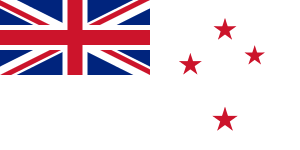Royal New Zealand Navy plans
The Royal New Zealand Navy has several long-term projects to retain and update its capabilities for the future.
Current planning framework
Defence White Paper
The Defence White Paper was released by the New Zealand Government in June 2016 ,.[1] Policy intentions regarding the replacement of existing ships include:
Short term (next five years):
- Naval Patrol Force: The acquisition of an ice strengthened Ocean Patrol Vessel in support of operations in the Southern Ocean and Antarctic.
- Replacement of HMNZS Endeavour with an ice strengthened Tanker to support New Zealand's contribution to research in Antarctic. On 18 July 2016 the Minister of Defence announced that Hyundai Heavy Industries of South Korea had been awarded a contract for NZ$493,000,000 for the purchase of a new 23,000t tanker. The new tanker will be ice strengthened with winterisation features. The ship is due for delivery in 2020.[2]
- Replacement of HMNZS Manawanui and HMNZS Resolution with a single Littoral Operations Support Vessel. It is expected that the vessel will also increase the range of operations the Defence Force can undertake independently in the South Pacific, and add depth to its maritime surveillance and sea transport capabilities. The vessel would also provide an additional deployment option for international coalition operations.[3]
Out to 2030
- Start a project for the replacement of the Anzac frigates that will take account of the wider range of naval combat options expected to be available then.
Other proposals
- Phasing out of the inshore patrol craft.
Long-Term Development Plan (LTDP)
Is a planning tool to enable decisions on defence acquisitions to be taken in the context of the Government’s defence policy, the priority of projects and affordability. This LTDP contains a comprehensive list of projects, with preliminary costing, timings, and priorities. The LTDP has a rolling forward focus of 10 years and was constructed as an active document and was last updated in 2008. Since the last update the New Zealand government released its Defence White Paper in June 2016.
The LTDP:
- Describes major acquisition projects required over the next 10 years to provide military capabilities that meet the Government’s defence policy objectives;
- Reflects relative priorities of the projects, measured against the Government’s defence policy and security needs and interests;
- Works within agreed financial limitations; and
- Sets out planning and decision-making processes incorporating management of both operational and financial risks to ensure that investment in defence provides best value for money.
The LTDP sets out several categories of projects. These are:
- Projects Approved in Principle by Government
- Projects Necessary to Avoid the Failure of Policy
- Projects Necessary to Provide a Well-Equipped Land Force
- Projects Necessary to Avoid Significant Risks to Policy
- Projects that have Benefit but are Less Critical to Achieving Policy Objectives
Allocation of a project to a particular category does not necessarily reflect the order in which they will be started.
System and platform upgrades
- Projects necessary to avoid the failure of policy
Anzac Self-Defence Upgrade This project proposes to upgrade the Anzac frigates' self-defence systems to protect the Naval Combat Force against increasingly sophisticated anti-ship systems and to address equipment obsolescence. Lockheed Martin Canada (LMC) was awarded a contract on 29 April 2014 for the design and supply of the Combat Management System for each ANZAC Class Frigate along with the supply and integration of various sensors, missile system and a Combat System Trainer for the Devonport Naval Base in Auckland.[4]
Torpedo Replacement This project proposes to replace the torpedoes for the Anzac frigates, P-3 Orions and SH-2G Seasprite helicopters to maintain the Anzac's basic self-defence capability against sub-surface threats and the P-3's area anti-submarine capability.
- Projects that have benefit but are less critical to achieving policy objectives
Remote Mine Detection The Maritime Forces Review identified a requirement to protect New Zealand's major ports by developing a capacity to detect and dispose of mines and other explosives underwater. The Review concluded that the mine countermeasures role should be retained. The capability of the Navy to detect mine-like objects is becoming increasingly difficult as current equipment reaches the end of its economical life. Upgrading this capability would significantly improve the safety of personnel and ships over the current inadequate, emergency only, systems. A request for information was released on 4 July 2016 by the Ministry of Defence.[5]
References
- ↑ http://www.nzdf.mil.nz/corporate-documents/defence-white-paper/
- ↑ "New naval tanker to have enhanced capabilities". The Beehive. Retrieved 2016-07-19.
- ↑ 2016 New Zealand Defence Whitepaper.p46
- ↑ http://www.defence.govt.nz/acquisitions-tenders/current-acquisition-projects/anzac-ships-upgrade-fsu.html
- ↑ http://www.defence.govt.nz/acquisitions-tenders/rfi-losc.html
Further reading
- Defence White Paper 2010. Ministry of Defense, New Zealand Government. November 2010. ISBN 978-0-478-27831-6.

